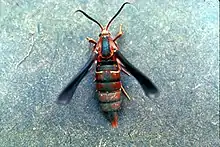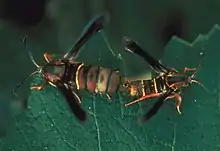| Vitacea polistiformis | |
|---|---|
 | |
 | |
| Scientific classification | |
| Domain: | Eukaryota |
| Kingdom: | Animalia |
| Phylum: | Arthropoda |
| Class: | Insecta |
| Order: | Lepidoptera |
| Family: | Sesiidae |
| Genus: | Vitacea |
| Species: | V. polistiformis |
| Binomial name | |
| Vitacea polistiformis | |
| Synonyms | |
| |
Vitacea polistiformis, the grape root borer, is a moth of the family Sesiidae. It is found throughout the midwest of the United States, south to Florida and Texas.[2] It is the most serious threat to grapes in Florida.
Adults are brown with thin yellow bands on the abdomen and resemble paper wasps. The front wings are brown while hind wings are transparent.
The larvae feed on grape species. The eggs hatch on the soil surface and the larvae tunnels into the root system of their host plant. The damage causes reduces vine growth, smaller leaves and reduced berry size.[3] It can reduce productivity as much as 47%. Scientists are exploring the possibility of using soil acoustics to locate and combat infestations of pests.[4]
Gallery
 Larva
Larva Larva
Larva Pupa
Pupa Mating
Mating
References
- ↑ "Checklist of the Sesiidae of the World". Archived from the original on 2012-03-26. Retrieved 2012-03-26.
- ↑ Bug Guide
- ↑ Insect Pests of Grapes
- ↑ Eberle, Ute (9 February 2022). "Life in the soil was thought to be silent. What if it isn't?". Knowable Magazine. doi:10.1146/knowable-020922-2. Retrieved 15 February 2022.
External links
Wikispecies has information related to Vitacea polistiformis.
Wikimedia Commons has media related to Vitacea polistiformis.
This article is issued from Wikipedia. The text is licensed under Creative Commons - Attribution - Sharealike. Additional terms may apply for the media files.